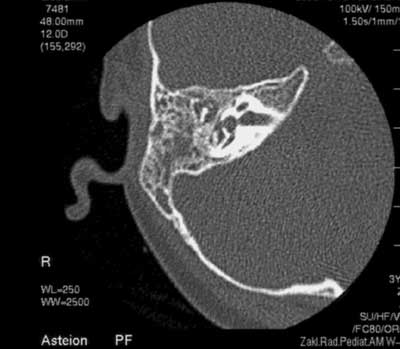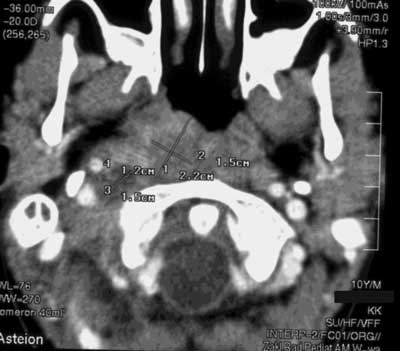© Borgis - New Medicine 4/2009, s. 82-84
Lechosław P. Chmielik, *Magdalena Fršckiewicz, Mieczysław Chmielik
COMPLICATIONS OF OTITIS MEDIA IN CHILDREN TREATED IN THE ENT PAEDIATRIC CLINIC OF WARSAW MEDICAL UNIVERSITY
Department of Paediatric Otorhinolaryngology, Medical University of Warsaw, Poland
Head of Department: Prof. Mieczysław Chmielik, MD, PhD
Summary
Introduction. Otitis media is one of the most common diseases among children. Difficulties with treating acute and chronic otitis media may result among other things in insufficient drug penetration to the inflammatory focus, inadequate dose of drugs or antibiotic, or increasing drug resistance of microorganisms. Complications of otitis media are divided into: intra-temporal, intracranial and systemic complications.
Aim. The aim of this research was the analysis of diagnostic and therapeutic procedures in children treated for complications of otitis media in the ENT Paediatric Clinic of Warsaw Medical University.
Material and method. The case histories of 38 children treated in the ENT Paediatric Clinic of Warsaw Medical University in the period between January 2005 and March 2009 were studied. The aim of the analysis was: clinical picture, course of disease, diagnostic and therapeutic procedures as well as the results of the treatment.
Results. There were 21 children (55.26% of analyzed patients) with mastoiditis, 6 children (15.78% of analyzed patients) with facial palsy, 1 child with fistula of the semicircular lateral canal, 4 children with thrombosis sigmoid sinusitis, and 2 children with systemic complication.
Conclusions. 1. The clinical view of otitis media complications has been changing and very few cases correspond with their description in the literature. 2. In case of otitis media complications the coordination of pharmacological and surgical treatment is necessary. 3. All otitis media complications require hospitalization. 4. Progress in pharmacological treatment enables less aggressive surgical treatment.
INTRODUCTION
Otitis media is one of the most common diseases among children. Difficulties with treating acute and chronic otitis media may result among other things in insufficient drug penetration to the inflammatory focus, inadequate dose of drugs or antibiotic, or increasing drug resistance of microorganisms. The consequence of this may be uncontrollable course of disease leading to complications. Malformations and anatomical dissimilarities may predispose to complications in otitis media. Complications of otitis media are divided into (2, 4, 8, 9, 10):
– intra-temporal: mastoiditis, facial palsy or paresis, inflammation of inner ear and inflammation of temporal bone pyramid;
– intracranial: epidural and subdural abscess, thrombosis sigmoid sinusitis, meningitis, cerebral or cerebellar abscess;
– systemic complications: sepsis and distant abscesses.
The majority of complications of otitis media are the result of a chronic inflammatory process. An exception is mastoiditis during acute otitis media of infants. The most common pathogens of otitis media are: Haemophilus influenzae, Streptococcus pneumoniae, Staphylococcus aureus (2, 4). In chronic otitis occurrence of anaerobes, staphylococci, Pseudomonas aeruginosa and Proteus is possible. Before the common use of antibiotics intracranial complications of otitis media occurred in 2.3% of cases.
AIM
The aim of this research was the analysis of diagnostic and therapeutic procedures in children treated for complications of otitis media in the ENT Paediatric Clinic of Warsaw Medical University in the period between January 2005 and March 2009.
MATERIAL AND METHOD
The case histories of 38 children treated in the ENT Paediatric Clinic of Warsaw Medical University in the period between January 2005 and March 2009 were studied. The aim of the analysis was: clinical picture, course of disease, diagnostic and therapeutic procedures as well as the results of the treatment.
RESULTS
1. There were 21 children (55.26% of analyzed patients) with mastoiditis (fig. 1):

Fig. 1. CT of mastoiditis.
– 1 case of infiltration of base of the brain during mastoiditis;
A boy with limitation of neck movement and infiltration of the mastoid process was admitted to the Clinic. In computed tomography of the temporal bones and neck provided by the Paediatric Radiology Department of Warsaw Medical University (Fig. 2) inflammatory lesions of the right and left mastoid process as well as a lesion of soft tissues of the neck reaching the base of the skull were detected. After bilateral antromastoidectomy and antibiotic therapy the lesions were limited. Symptoms of disease abated after 3 days. After discharge the lesion was controlled by MRI examination in an outpatient clinic.

Fig. 2. CT of inflammatory lesion of parapharyngeal region.
– in the analyzed group in 12 cases paracentesis was performed and in 12 cases antromastoidectomy;
– bacteriological examination revealed: Streptococcus pyogenes, Streptococcus pneumoniae, Staphylococcus epidermidis, Staphylococcus opalis, Staphylococcus coagulase(-), Haemophilus influenzae, Pseudomonas aeroginosa, Corynebacterium pseudodiphtericum, Enterococcus faecalis, Candida albicans;
– intravenous antibiotic therapy was performed using: amoxicillin/clavulanic acid, cefuroxime, ceftriaxone, Flumycon, vancomycin, ceftazidime, norfloxacin, cefotaxime, clarithromycin.
2. There were 6 children (15.78% of analyzed patients) with facial palsy:
– 3 of 6 children were treated non-invasively by rehabilitation;
– in 3 of 6 cases paracentesis was performed;
– in 2 of 6 cases antromastoidectomy was performed
– antibiotic therapy was performed using: amoxicillin//clavulanic acid, clindamycin, cefuroxime, ceftazidime, ceftriaxone;
– in all 6 cases improvement of facial nerve function was obtained.
3. There was 1 child with fistula of the semicircular lateral canal:
– a 4-year-old boy was admitted to the Clinic because of failure to respond to treatment for right otitis media and fever;
– in CT performed by the Paediatric Radiology Department destruction of the semicircular lateral canal was noted;
– antromastoidectomy with reconstruction of the semicircular lateral canal was performed (in 8 days after the procedure sutures split apart);
– in the ear inoculation Mycobacterium tuberculosis was identified;
– antibiotic therapy was performed using: clindamycin, cefuroxime, ceftriaxone, amoxycillin/clavulanic acid, isoniazid, rifampicin, pyrazinamide;
– the patient was transferred to the Paediatric Allergology and Pulmonology Clinic of Warsaw Medical University;
– after recovery and the end of anti-Mycobacterium tuberculosis treatment the hearing examination was correct.
4. There were 4 children with thrombotic sigmoid sinusitis:
– symptoms included: strabismus (4 children), choked disc (4 children), headaches (3 children), vomiting (2 children);
– non-invasive treatment included antithrombotic treatment performed using: fraxiparine (3 children), clexane (1 child) and antibiotic therapy: amoxicillin/ /clavulanic acid, tertiaxon, Netromycin, Flumycon (4 children);
– paracentesis was performed in 2 children; however, it required antromastoidectomy;
– antromastoidectomy was performed in 4 children;
– in 3 cases symptoms abated completely and in 1 case strabismus only increased;
– after the surgical treatment children were transferred to the Paediatric Neurology Clinic.
5. There were 2 children with systemic complication:
– sepsis;
– paracentesis was performed in 1 case;
– antromastoidectomy was performed in 1 case;
– antibiotic therapy was performed using: clindamycin, cefuroxime, vancomycin, imipenem;
– 1 child was transferred to the Intensive Care Unit;
– 1 child was transferred to the Paediatric Department.
DISCUSSION
Introduction of antibiotic therapy in the 20th century has led to reduction of the frequency of complications of otitis media. However, they still occur. According to the literature, the most common complication of otitis media is mastoiditis (8, 9). This was also confirmed in our research. In the analyzed group there was one case of infiltration of the skull base, but without malacia. Most probably it was a form of Bezold´s abscess, held in an early phase of development, due to combined non-invasive and surgical treatment. In the case of facial palsy, apart from adequate rehabilitation, decompression of the middle ear seems to be also important. Tuberculous otitis media, which nowadays is more common because of the increasing number of tuberculosis infections, is one of the rare forms of otitis media. The image of tuberculosis has been changing and it is increasingly rare to find a typical form of this illness, as was confirmed in the presented case (1, 7). Using adequate treatment in an early stage of disease the proper therapeutic effects can be achieved. Treating thrombotic sigmoid sinusitis by using combined fibrinolytic and antibiotic treatment may lead to limitation of the level of aggressive surgical treatment. In the analyzed group in all the cases, the reversion of thrombotic and static lesions was observed, while strabismus abated entirely in 75% of the cases. In cases of thrombotic sigmoid sinusitis some researchers do ligation of the sigmoid sinus, while others limit such procedures only to cases with distant abscesses (3, 5, 6). According to the experience of the authors of this article, the use of polypragmatic treatment may lead to less aggressive surgical treatment while achieving satisfactory clinical results at the same time.
CONCLUSIONS
1. The clinical view of otitis media complications has been changing and very few cases correspond with their description in the literature.
2. In case of otitis media complications the coordination of pharmacological and surgical treatment is necessary.
3. All otitis media complications require hospitalization.
4. Progress in pharmacological treatment enables less aggressive surgical treatment.
Piśmiennictwo
1. Chmielik LP, Ziołkowski J, Koziolek R et al.: Ear tuberculosis: clinical and surgical treatment. International Journal of Pediatric Otalaryngology 2008; 72, 271-274. 2. Chmielik M: Otolaryngologia dziecięca PZWL 2001, 279-306. 3. Iwaszkiewicz S. Po?piech L: Operacje powikłań usznopochodnych. Techniki zabiegów i operacji. W: Otolaryngologii (red.) Latkowski B. PZWL 200; 205-207. 4. Mierzwiński J, Fishman AJ: Przewlekłe zapalenie ucha ?rodkowego. Otolaryngologia dziecięca (red.) Gryczyńska D, α medica Press 2007; 95-142. 5. Mierzwiński J, Fishman AJ: Przewlekłe zapalenie ucha ?rodkowego. Otolaryngologia dziecięca (red.) Gryczyńska D, α medica Press 2007; 128. 6. Ooi EH, Hilton M, Hunter G: Management of lateral sinus thrombosis: update and literature review. J. Laryngol. Otol 2003; 117(12), 932-9. 7. Piziewicz A, Mierzwiński J: Two cases of tuberculous otitis media in children. The new Frontiers of Oto-Rhino-Laryngology in Europe Motta G. Ed. Monduzzi Editore, Bologna 1992; 167-172. 8. Otolaryngologia Dziecięca (red.) D. Gryczyńskiej, 2007. 9. Bluestone, Stool, Alper et al.: Pediatric Otolaryngology. Saunders 2003. 10. Bianchini C, Aimoni C, Ceruti S et al.: Lateral sinus thrombosis as a complication of acute mastoiditis. Acta Otorhinolaryngol Ital 2008; Feb 28(1): 30-3.

